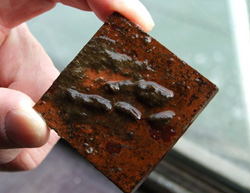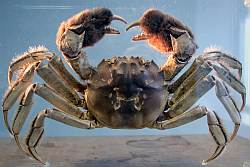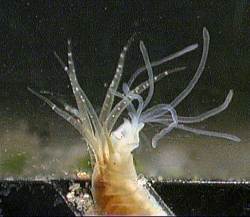Forschung
Auswahl von aktuellen Forschungsthemen der Ökologischen Rheinstation
Biofilm-Forschung im Rhein

Biofilm. Foto: A. Scherwaß© Universität zu Köln
Klimafolgen-Forschung und Ökosystemfunktion von invasiven Arten (Neozoen)

Bentho-pelagische Kopplung (Konsum von Plankton durch bodenbewohnende Tiere)

Publikationen
Hier finden Sie ausgewählte Publikationen, deren grundlegende Forschungsarbeit ganz oder teilweise in den Laboren der Ökologischen Rheinstation erfolgten:
- Kureck, A., Bieg, R., Wendeler, R., Borcherding, J. (2014):
Fecunditiy of the mayfly Ephoron virgo (Olivier, 1791) (Ephemeroptera: Polymitarcidae): A long-term study in the River Rhine. Limnologica 47: 1-6 - Ackermann, B., Esser, M., Scherwaß, A., Arndt, H. (2011):
Long-term dynamics of microbial biofilm communities of the River Rhine with special references to ciliates. Int. Revue Hydrobiol. 96:1-19 - Vohmann, A., Borcherding, J., Kureck, A., Bij de Vaate, A., Arndt, H. & Weitere, M. (2010):
Strong body mass decrease of the invasive clam Corbicula fluminea during summer. Biological Invasions 12: 53-64 - Weitere, M., Vohmann, A., Schulz, N., Linn, C., Dietrich D. and Arndt, H. (2009):
Linking environmental warming to the fitness of the invasive clam Corbicula fluminea - Norf, H., Arndt, H. and Weitere, M. (2009):
Effects of resource supplements on mature ciliate biofilms: an empirical test using a new type of flow cell - Vohmann, A., Mutz, M., Arndt A. and Weitere M. (2009):
Grazing impact and phenology of the freshwater sponge Ephydatia muelleri and the bryozoans Plumatella emarginata and Fredericella sultana under experimental warming - Bergfeld, T., Scherwass, A., Ackermann, B., Arndt, H. and Schöl, A. (2009):
Comparison of the components of the planktonic food web in three large rivers
(Rhine, Moselle and Saar). River Research and Applications: 25 (10), 1232-1250 - Norf, H., Arndt, H., Weitere, M. (2009):
Effects of resource supplements on mature ciliate biofilms: an empirical test using a new type of flow cell. Biofouling 25 (6), 769-778 - Weitere, M., Dahlmann, J., Viergutz, C., Arndt, H. (2008):
Differential grazer-mediated effects of high summer temperatures on pico- and nanoplankton communities. Limnol. Oceanogr. 53 (2), 1-10 - Wey, J.K., Scherwass, A., Norf, H., Arndt, H., Weitere, M. (2008):
Effects of protozoan grazing within river biofilms under semi-natural conditions. AME 52, 283-296 - Norf, H., Arndt, H., Weitere, M. (2007):
Impact of local temperature increase on the early development of biofilm-associated ciliate communities. Oecologia 151,2, 341-350 - Viergutz, C., Kathol, M., Norf, H., Arndt, H., Weitere, M. (2007): Control of microbial communities by the macrofauna: a sensitive interaction in the context of extreme summer temperatures? Oecologia 151,1, 115-124
- Weitere, M., Scherwass, A., Sieben, K.-T., Friedrich, G., Arndt, H. (2005):
Planctonic Food Web Structure and Potential Carbon Flow in the Lower River Rhine with a Focus on the Role of the Protozoans. River Research and Applications: 21, 535-549
Reviews
- BOENIGK, J. & ARNDT, H. (2002):
Bacterivory by heterotrophic flagellates: community structure and feeding strategies. Antonie van Leeuwenhoek 81: 465-480 - ARNDT, H., SCHMIDT-DENTER, K., AUER, B. & WEITERE, M. (2003):
Protozoans and biofilms. In: Fossil and Recent Biofilms (Krumbein, W.E., Paterson, D.M. & Zavarzin, G.A., Eds.) Kluwer Academic Publ., Dordrecht., p. 173-189